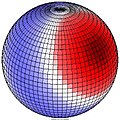Pierre-Simon Laplace
Pierre-Simon Laplace (23 March 1749 – 5 March 1827), later Marquis de Laplace, was a French mathematician and astronomer.
Pierre-Simon, Marquis de Laplace | |
|---|---|
 Pierre-Simon Laplace (1749–1827). Posthumous portrait by Madame Feytaud, 1842 | |
| Born | 23 March 1749 |
| Died | 5 March 1827 (aged 77) |
| Nationality | |
| Alma mater | University of Caen |
| Known for | Work in Celestial Mechanics Laplace's equation Laplace operator Laplace transform Laplace distribution Laplace's demon Laplace expansion Young–Laplace equation Laplace number Laplace limit Laplace invariant Laplace principle |
| Scientific career | |
| Fields | Astronomer and Mathematician |
| Institutions | École Militaire (1769–1776) |
| Academic advisors | Jean d'Alembert Christophe Gadbled Pierre Le Canu |
| Doctoral students | Siméon Denis Poisson |
| Signature | |
 | |
His work helped to develop mathematical astronomy and statistics. His five volume Mécanique Céleste (Celestial Mechanics) (1799–1825) was a key work. In it, he changed the geometric study of classical mechanics to one based on calculus, which meant it could tackle a wider range of problems. In statistics, the so-called Bayesian interpretation of probability was mainly developed by Laplace.[1]
He invented Laplace's equation, and pioneered the Laplace transform which is used in many branches of mathematical physics. The Laplacian differential operator, widely used in mathematics, is also named after him.[2]
Astronomy
Solar system
Laplace's view on the origin of the Solar System is still ours today. He recognised, like Newton, that the key force in the Solar System was gravitation. Gravitation caused the coming together of gas and small particles into one central mass (which became the Sun) with other smaller groups (the planets), held to the central star by gravitation.[3]
Laplace proved that the small irregularities in planetary motion were self-correcting, and that the solar system as a whole was stable. This meant the solar system was going to exist in the present state for a very long time. He worked out some problems in the moon's orbit, and how the moon caused tides.
Black holes
Laplace also came close to getting the concept of the black hole. He pointed out that there could be massive stars whose gravity is so great that not even light could escape from their surface (see escape velocity).[4] Laplace also speculated that some of the nebulae revealed by telescopes may not be part of the Milky Way and might actually be galaxies themselves.[5] Thus, he anticipated Edwin Hubble's major discovery 100 years in advance.
Quotes
- "What we know is not much. What we do not know is immense". (attributed)
- "I had no need of that hypothesis". (Je n'avais pas besoin de cette hypothèse-là, as a reply to Napoleon, who had asked why he hadn't mentioned God in his book on astronomy).[6]
- "It is therefore obvious that ..." (Il est facile de voir que...) a phrase frequently used in the Celestial Mechanics when he had proved something and mislaid the proof, or found it clumsy. Notorious as a signal for something true, but hard to prove.
- "The weight of evidence for an extraordinary claim must be proportioned to its strangeness".[7]
- "...[This simplicity of ratios will not appear astonishing if we consider that] all the effects of nature are only mathematical results of a small number of immutable laws".[8]
Pierre-Simon Laplace Media
Portrait of Pierre-Simon Laplace by Johann Ernst Heinsius (1775)
Title page of an 1817 copy of Delambre's "Tables écliptiques des satellites de Jupiter", which references Laplace's contributions in its title
Tables in an 1817 copy of Delambre's "Tables écliptiques des satellites de Jupiter" – these calculations were influenced by Laplace's previous discoveries.
References
- ↑ Stephen M. Stigler 1986. The history of statistics. Harvard University press. Chapter 3.
- ↑ [Anon.] (1911) "Pierre Simon, Marquis De Laplace", Encyclopaedia Britannica
- ↑ Laplace, Pierre-Simon 1796. Exposition du Système du Monde. This has in a footnote his famous 'nebular hypothesis'.
- ↑ Israel, Werner 1987. Dark stars: the evolution of an idea. In Hawking, Stephen W. & Israel, Werner (eds) 300 years of gravitation. Cambridge University Press. section 7.2
- ↑ Thompson, Todd. "Astronomy 162: Lecture 23". Astronomy 162: Introduction to Stars, Galaxies, and Cosmology. Ohio State University. Retrieved 28 July 2025.
- ↑ Rouse Ball W.W. [1908] 2003. Pierre Simon Laplace (1749–1827), in A short account of the history of mathematics. 4th ed, Dover. ISBN 0486206300
- ↑ A sense of place in the heartland Archived 2008-03-06 at the Wayback Machine, The Milwaukee Journal Sentinel Online
- ↑ Laplace, Pierre Simon, A philosophical essay on probabilities, translated from the 6th French edition. Dover Publications, New York, 1951. p4







